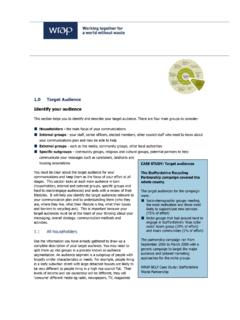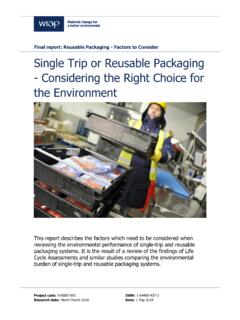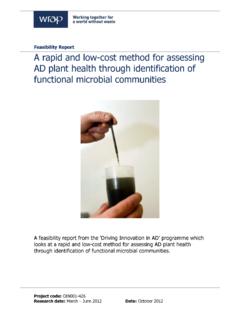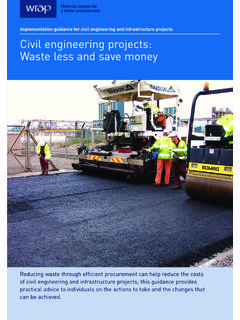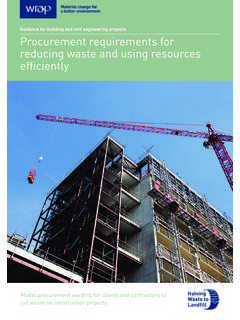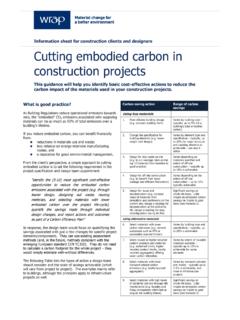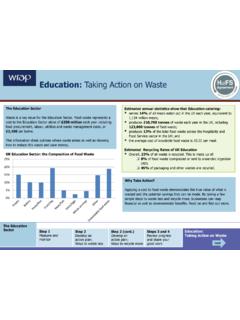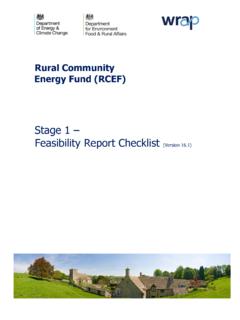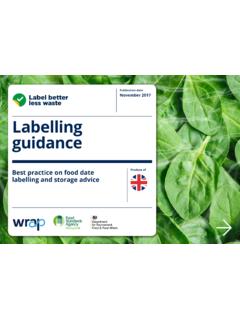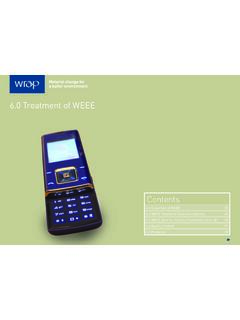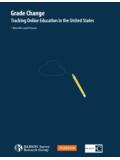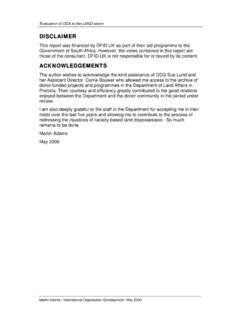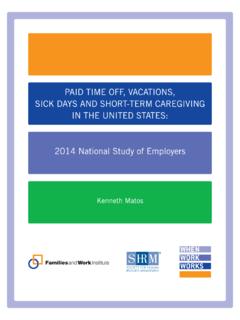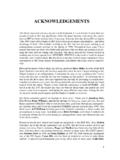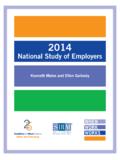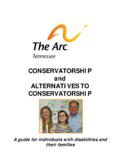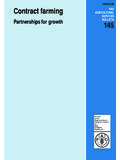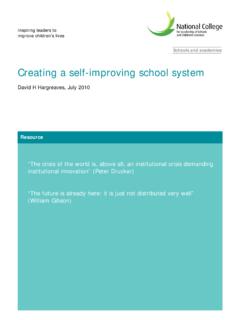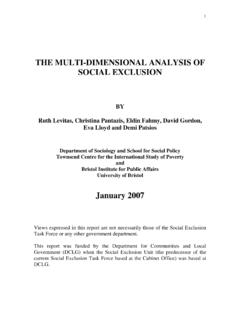Transcription of Recycling of laminated packaging - WRAP
1 Project report Recycling of laminated packaging Trials to optimise pilot plant for Recycling of laminated packaging wastes Project code: MDP037 Research date: September 2010 to April 2011 Date: September 2011 WRAP s vision is a world without waste, where resources are used sustainably. We work with businesses and individuals to help them reap the benefits of reducing waste, develop sustainable products and use resources in an efficient way. Find out more at Document reference: [ WRAP, 2006, Report Name (WRAP Project TYR009-19. Report prepared , WRAP] Written by: Stephen Slater and Trevor Crichton, Oakdene Hollins Ltd Front cover photography: Examples of laminated retail packaging WRAP and Oakdene Hollins Ltd believe the content of this report to be correct as at the date of writing. However, factors such as prices, levels of recycled content and regulatory requirements are subject to change and users of the report should check with their suppliers to confirm the current situation.)
2 In addition, care should be taken in using any of the cost information provided as it is based upon numerous project-specific assumptions (such as scale, location, tender context, etc.). The report does not claim to be exhaustive, nor does it claim to cover all relevant products and specifications available on the market. While steps have been taken to ensure accuracy, WRAP cannot accept responsibility or be held liable to any person for any loss or damage arising out of or in connection with this information being inaccurate, incomplete or misleading. It is the responsibility of the potential user of a material or product to consult with the supplier or manufacturer and ascertain whether a particular product will satisfy their specific requirements. The listing or featuring of a particular product or company does not constitute an endorsement by WRAP and WRAP cannot guarantee the performance of individual products or materials.
3 This material is copyrighted. It may be reproduced free of charge subject to the material being accurate and not used in a misleading context. The source of the material must be identified and the copyright status acknowledged. This material must not be used to endorse or used to suggest WRAP s endorsement of a commercial product or service. For more detail, please refer to WRAP s Terms & Conditions on its web site: Recycling of laminated packaging 1 Executive summary laminated films used in the manufacture of the packaging targeted for this project are an increasingly popular option for lightweight product packaging . They comprise a thin foil of aluminium, which is sandwiched, or laminated in a matrix of paper and/or plastic layers, and are used in a range of packaging formats, including pouches, bags and tubes, for the packaging of consumer goods such as food, drinks, pet foods, toothpastes, and cosmetic products.
4 For convenience, this report refers to the range of products as laminated packaging . Because of the relative lightness of laminated packaging , and due to the absence of a commercially viable Recycling process, it has not historically been a targeted material for collection by local authorities, as are other, more common forms of packaging . Enval Limited has developed a technology for Recycling these materials. The process is based on a technology known as Microwave Induced Pyrolysis, which is a pyrolytic process in which the energy required for heating the material is provided by microwaves. The outputs are aluminium flakes, and hydrocarbons, in the form of an oil and a gas, suitable for the production of energy. This report details a series of trials, using a pilot plant built by Enval, to process laminated packaging as a post-consumer waste and reviews the technical, commercial and environmental performance of the process.
5 The project involved research into the market for laminated packaging , including the mix, form and quality of typical materials, how they might be recovered from the household waste stream, practical trials of the process using the pilot plant, and detailed analysis of the findings. A total of six process trials were performed using a total of 600kg of a recipe of laminated packaging which was formulated to closely simulate the predicted post-consumer mix, including product residues and non-target contamination materials. Output materials were tested for quality and chemical composition. The aluminium was valued by potential reprocessors and the hydrocarbons were priced based on their useable energy equivalents. The results indicate that the process is technologically and environmentally sound. The carbon emissions associated with the process would be approximately half of that associated with the production of primary aluminium alone.
6 This environmental benefit will be considerably greater in practice due to the surplus energy available from the recovered hydrocarbon outputs which would substitute for non-sustainable energy sources. The most conservative estimate of the size of the UK market for laminated packaging is some 139,000 tonnes annually, containing approximately 13,500 tonnes of aluminium. Some laminated packaging formats are estimated to be growing by between 10% and 15% per year. In assessing the commercial viability of the process, it was assumed that post-consumer laminated packaging would become a targeted kerbside recyclable material by waste collection authorities within regions, each supplying one materials recovery facility (MRF). It was further assumed that it would be possible to access one-third of the total laminated packaging disposed by households following a suitable promotional campaign within any region.
7 In this way, the amount of material recovered in any region would be sufficient to feed a commercial scale processing system of 2,000 tonnes per annum gross capacity. This could be placed within, or adjacent to, the MRF. Prior to this happening, the plant will require further development to be sufficiently robust and reliable for operation by semi-skilled operatives. Some modifications would be required within the MRF to automatically recover the materials separately from other aluminium based materials, in particular, used Recycling of laminated packaging 2 beverage cans. Based on these assumptions, and including the costs of the modifications to the MRF and those of the transportation of materials, it is estimated that a minimum payback of some four years would be achieved from investment in each commercial scale processing plant. The lifetime of the plant is at least ten years.
8 The payback period, based on the value of the aluminium and the hydrocarbons and the avoided landfill costs, would be improved if the percentage of aluminium in the waste mix was increased, either by the addition of cleaner, post-industrial, waste laminated packaging to the feedstock or by the collection of additional aluminium packaging within the MRF sorting processes. Recycling of laminated packaging 3 Contents Introduction .. 5 Aluminium/plastic laminated packaging .. 5 Objectives of the project .. 5 Methodology .. 6 Report layout .. 7 laminated packaging .. 8 Materials and applications .. 8 Summary of market size, market trends and product mass .. 9 The Enval process .. 9 Phase I - Initial research .. 11 Introduction .. 11 Market size .. 11 Determination of post-consumer material mix .. 12 Practical tests with sorted materials from the household waste stream.
9 12 Establishing a feedstock recipe for the process trials .. 13 Phase 2 - Process trials at Enval .. 15 Introduction .. 15 Waste preparation .. 15 Process trials .. 17 Equipment and method .. 17 Trial method .. 19 Phase 2 (continued) Results of process trials .. 20 Magnetron power .. 20 Mass balance analysis and process optimisation .. 20 Chemical analysis of the condensable and non-condensable products .. 23 Analysis of aluminium .. 26 Proof of principle .. 27 Phase 2 (continued) - Materials sorting trials at a MRF .. 28 Financial analysis .. 30 Overview of business model .. 30 Assumptions .. 30 Detailed explanation of products properties, yields and prices .. 31 Results .. 32 Environmental analysis .. 34 Methodology .. 34 Objective and scope definition .. 34 System boundaries .. 34 Data collection .. 35 Results .. 36 Glossary MBT Mechanical-Biological Treatment MRF Material Recovery Facility NE Nichteisen [non-ferrous] 2D Two-dimensional 3D Three-dimensional Recycling of laminated packaging 4 Acknowledgements We are especially grateful to Enval Ltd, Donarbon Ltd, the Aluminium packaging Recycling Organisation (Alupro) and Bywaters Ltd for their assistance in the production of this report.
10 Recycling of laminated packaging 5 Introduction Aluminium/plastic laminated packaging As a result of a twin approach to making packaging more reliable whilst minimising its environmental impact, there have been many developments in the packaging sector and one product of these developments has been the aluminium/plastic laminate which is commonly used as packaging for consumer goods such as such as food, drinks, pet foods, toothpastes and cosmetic products. For convenience, this report refers to the packaging under consideration as laminated packaging . laminated packaging has become a concern within the Recycling sector because, by its very design, it is of low weight, relatively low value, and has, to date, been considered to be completely unrecyclable. In an environment where collection and recovery of recyclates is driven by weight-based targets, they will not be highlighted as an issue until heavier packaging options have been replaced.
